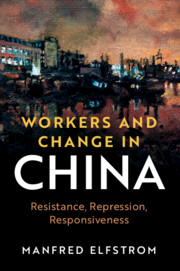Book contents
- Workers and Change in China
- Cambridge Studies in Contentious Politics
- Workers and Change in China
- Copyright page
- Dedication
- Contents
- Figures
- Maps
- Tables
- Acknowledgments
- 1 Introduction
- 2 Recipes for Resistance
- 3 Bureaucratic Incentives
- 4 Orthodox Control
- 5 Risk-Taking Control
- 6 Increased Repressive and Responsive Capacity
- 7 Bottom-Up versus Top-Down Change
- 8 Conclusion
- Appendices
- References
- Index
- Series page
7 - Bottom-Up versus Top-Down Change
Published online by Cambridge University Press: 14 January 2021
- Workers and Change in China
- Cambridge Studies in Contentious Politics
- Workers and Change in China
- Copyright page
- Dedication
- Contents
- Figures
- Maps
- Tables
- Acknowledgments
- 1 Introduction
- 2 Recipes for Resistance
- 3 Bureaucratic Incentives
- 4 Orthodox Control
- 5 Risk-Taking Control
- 6 Increased Repressive and Responsive Capacity
- 7 Bottom-Up versus Top-Down Change
- 8 Conclusion
- Appendices
- References
- Index
- Series page
Summary
Throughout this book, I have argued that worker resistance is powerfully altering governance in the People’s Republic, albeit in a contradictory manner. This is a forthrightly bottom-up perspective on the Chinese system. I have acknowledged complications to this schema at various points. For example, in the case studies in Chapters 4 and 5, I noted how state policies could double back to reshape the nature of labor mobilization regionally, for example, the Yangtze River Delta’s co-optation of labor NGOs might mean less boundary-spanning or transgressive organizations for the state to contend with down the line, making harsher measures less necessary. Moreover, in the statistical work in the previous chapter, I explicitly tested for reverse causality and found evidence that pro-worker and split decisions in formally adjudicated employment disputes are both a product of and a cause of strikes, protests, and riots (although I found that resistance drives down pro-business decisions even when this feedback is accounted for). Nonetheless, the issue of the precise role played by elite politics in labor politics deserves more focused attention for at least two reasons. First, at a regional level, officials, while all disciplined by the same cadre promotion system, clearly approach stability maintenance in ways that are informed by their own, idiosyncratic perspectives, with implications for both sub-national policies and local levels of unrest. Second, nationally, changes between administrations have obviously coincided with different degrees of political openness, including in the arena of industrial relations. The current government of Xi Jinping has been extraordinarily harsh on dissent. Again, this dynamic could affect both ends of the protest-policy relationship, encouraging/discouraging workers while ramping up/dialing down repression and responsiveness. Do these dynamics fundamentally undercut the arguments advanced thus far? Put differently, could top-down pressures dominate bottom-up ones in the final analysis?
- Type
- Chapter
- Information
- Workers and Change in ChinaResistance, Repression, Responsiveness, pp. 129 - 145Publisher: Cambridge University PressPrint publication year: 2021



